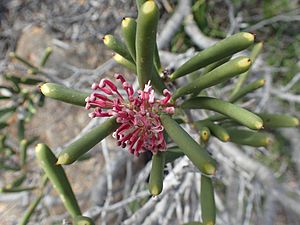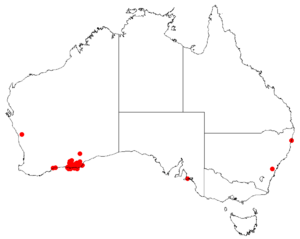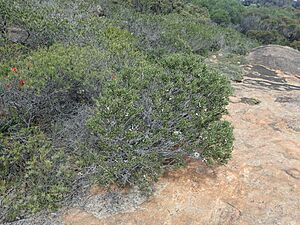Coastal hakea facts for kids
Quick facts for kids Coastal hakea |
|
|---|---|
 |
|
| Hakea clavata in the Cape Le Grand National Park | |
| Scientific classification | |
| Genus: |
Hakea
|
| Species: |
clavata
|
 |
|
| Occurrence data from AVH | |
The Hakea clavata, often called coastal hakea, is a type of shrub. It grows only in a specific area along the southern coast of Western Australia. This means it is endemic to that region.
This special plant has thick leaves and pretty pink and grey flowers. You can often find it growing on rocky areas.
What it Looks Like
Coastal hakea is a sprawling shrub that can spread out up to 2.5 meters (about 8 feet) wide. It usually grows between 0.5 and 2.0 meters (about 1.5 to 6.5 feet) tall. It has a special woody swelling at its base called a lignotuber. This helps the plant regrow after a fire.
Its leaves are a mid-green color and are quite thick. They are long and narrow, measuring from 2 to 8 centimeters (about 1 to 3 inches) long. Each leaf ends in a hard, sharp point. Some leaves might even be club-shaped, meaning they get wider at the tip.
The plant produces many flowers, usually 60 to 80 at a time. These flowers are white and pink and grow in small clusters along the branches. The outer part of the flower, called the perianth, has a pink base and grey tips. The inside of the flower is white.
After the flowers, the plant grows woody fruits. These fruits are egg-shaped and measure about 1.5 to 2.5 centimeters (about 0.6 to 1 inch) long. They have two small horn-like bumps on the back. Inside, you'll find black-brown seeds. Each seed is about 16 millimeters (about 0.6 inches) long and has a wide wing along one side.

How it Got its Name
The coastal hakea was first officially described in 1805 by a scientist named Jacques Labillardière. He wrote about it in his book, Novae Hollandiae plantarum specimen.
Labillardière might have collected a sample of this plant near Esperance, Western Australia in December 1792. The second part of its scientific name, clavata, comes from the Latin word clava. This word means "club," and it refers to the club-like shape of some of the plant's leaves.
Where it Grows
You can find the coastal hakea mainly along the mainland and on some islands. These areas are located between Israelite Bay and Esperance in Western Australia. There's also one known group of these plants further west, near Hopetoun, Western Australia.
This plant prefers to grow in rocky, sandy clay soils. It often grows among granite rocks. It's a tough plant that can handle strong, salty winds from the ocean.

